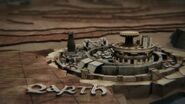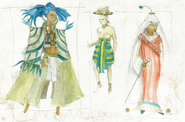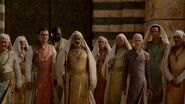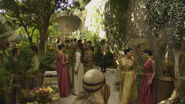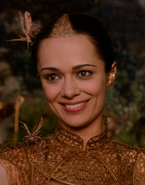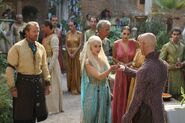- This page is about the city. For the short, see: Qarth (short)
- "We call Qarth "the Greatest City that Ever Was or Will Be". An easy claim to make if one knows only the docks and custom houses of other cities. An easy lie to swallow if a people only see the gold and jewels of their rulers, which we, the Thirteen who govern this city, are careful to ensure."
- ―Xaro Xhoan Daxos
Qarth[1] is a great trading city located on the southern coast of Essos, on the straits linking the Summer Sea to the Jade Sea. Ships from Westeros, the Free Cities, the Summer Isles, and Slaver's Bay all pass through the Straits of Qarth on their way to the great nations and trading centers of the Further East, such as Yi Ti and Asshai.
Unlike most cities in Essos, Qarth has no fear of the Dothraki, as the vast and forbidding Red Waste divides it from the Dothraki Sea. Nor was Qarth ever conquered by the old Valyrian Freehold.[2] While the Red Waste separates Qarth from land-based travel with other parts of Essos, its port is one of the greatest in the world, and the Qartheen use their strategic position to conduct brisk maritime trade with merchants from every land between Westeros and Asshai. Qarth seems to be located on an oasis, for despite being surrounded by desert, the inside of the city is tropical.
Qarth is defended by immense stone walls and strong gates, and the Qartheen have been known to bar entry to the city to those who do not meet their approval. Due to Qarth's isolation behind the Red Waste, being denied entry will often spell doom for travelers, and their bones can be found extending around its walls. This area is sometimes called the "Garden of Bones".
People and politics[]
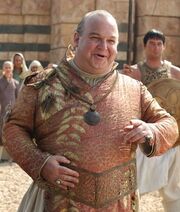
The Spice King, one of the thirteen Qartheen rulers.
The people of Qarth are known as the Qartheen and call their home "The greatest city that ever was or will be." The government of Qarth is an oligarchy headed by a council of nobles and merchants known as the Thirteen. Most representiatives on this council are members of the Pureborn, an aristocracy descending from the long-deposed Kings of Qarth. Although they rule by consensus, any member of the Thirteen can overrule a decision made by the rest by invoking sumai, pledging their life and their blood to back up their decision.[3]
Status is quite important among the Qartheen, and they tend to be very concerned about appearances; the men wear vests which are covered in extravagant gold tracing and jewelry on the front, and women sometimes dye their hair to appear more exotic. Both men and women decorate their clothing with gold pieces shaped like insects and encrusted with jewels. Appearances, however, are not only a matter of status among the Qartheen, but also of survival; among the Thirteen for example, those who do not hold hereditary seats will only remain on the council as long as they can appear wealthy and powerful before the eyes of the other twelve members. Any failure to keep up appearances and they will be removed and quickly replaced.
History[]
Game of Thrones: Season 1[]
Doreah of Lys, a pleasure slave and handmaiden in the service of Daenerys Targaryen, relates a story she heard from a trader from Qarth who visited her brothel. The Qartheen man said that there used to be two moons in the sky, but when one of them strayed too close to the heat of the sun it cracked open, releasing "a thousand thousand [1,000,000] dragons."[4]
Game of Thrones: Season 2[]
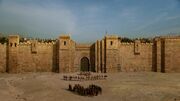
A view of Qarth's imposing walls.
Daenerys Targaryen and her khalasar are dying of thirst in the Red Waste. She dispatches her three bloodriders in search of succor.[5] Kovarro finds his way to the city of Qarth, located three days to the east, and guides Daenerys there. Outside she is greeted by the Thirteen, but when she refuses to show them her dragons they deny her entry. Xaro Xhoan Daxos overrides the decision of the council by invoking Sumai, an ancient Qartheen law, and takes Daenerys and her people under his protection.[3]
Some time later, a group of the wealthy Qartheen attend a gathering at Xaro Xhoan Daxos' manse to get to know Daenerys.[6]
Xaro Xhoan Daxos and Pyat Pree of the Warlocks of Qarth stage a coup in the city, assassinating the other members of the Thirteen and securing Daenerys's dragons for their own purpose, imprisoning them in the House of the Undying, the warlocks' tower.[7] Daenerys later rescues her dragons, having them burn Pyat Pree alive with dragonfire, before sealing Xaro Xhoan Daxos in his own vault - which turned out to be empty - as revenge for his subterfuge.[8]
Game of Thrones: Season 3[]
While meeting with Razdal mo Eraz outside of Yunkai, Daenerys demands the release of every slave in the city or she and her army of Unsullied will take it by force. Highly offended, Eraz spits back that Yunkai is not Astapor or Qarth, and that the Yunkai'i have "powerful friends" who would take great pleasure in bringing Daenerys down.[9]
Game of Thrones: Season 4[]
Upon learning of uprisings in Yunkai and Astapor, Daenerys speaks with Ser Jorah Mormont about a potential solution, reminiscing that in Qarth he warned her against acting rashly.[10]
Game of Thrones: Season 6[]
Euron Greyjoy remarks that he has been raiding ships across the world oceans, so that "from Oldtown to Qarth, when men see my sails, they pray."[11]
Game of Thrones: Season 8[]
During her speech after the Battle of King's Landing, Daenerys promises her army that they will free the world from tyrants from Lannisport to Qarth.[12]
Notable residents of the city[]
- The Spice King, a member of the Thirteen. Killed by Pyat Pree.
- The Silk King, a member of the Thirteen. Killed by Pyat Pree.
- The Copper King, a member of the Thirteen. Killed by Pyat Pree.
- Xaro Xhoan Daxos, a merchant prince native to the Summer Isles and an influential member of the Thirteen, self-proclaimed King of Qarth. Locked inside his own vault under orders of Daenerys Targaryen.
- Pyat Pree, a spokesman for the warlocks of Qarth. Killed by Drogon, Rhaegal and Viserion at the House of the Undying.
- Quaithe, a shadowbinder from Asshai established in Qarth.
Behind the scenes[]
When Daenerys first enters Qarth in "Garden of Bones", the wide shot of the city inside of the gates is not a location shot but almost entirely a special effects production, aside from the gates themselves and a few bushes. The production team wanted the gates themselves to have a look of age and a foreboding appearance, and inspired by the books they are covered with animal designs. The physical exterior set of the gates of Qarth was over 100 feet wide. It was constructed in Dubac quarry outside of Dubrovnik, Croatia, which had recently been flattened because it was going to be converted into a cemetery - thus the "Garden of Bones" outside the gates was about to be converted into an actual boneyard.
Costume Designer Michele Clapton explained that she wanted to show how the Qartheen are very opulent, but also that everything is a facade and for show. Thus the front of their costumes are lavish and ornate to impress others when they face them, but they don't bother to decorate the back of their clothing at all:
- "I always in my head, saw Qarth as a sort of mirage, so with that in mind, it's a sort of case of taking to Gemma about the architecture, obviously the climate. We started actually with the fabrics, really. We dyed all the silk, and then printed, it's almost like gilded gates on it, and then I had a painter who came in and actually painted the sort of fronds and the flowers and the gold behind the gate. With their underskirts, we actually had them baked in clay and then shook them out, and so it gives this lovely crumpled sort of weight to the fabric, that you really can't get any other way. And then with those costumes I wanted them to be able to be worn in different ways, so when they come out of the gates they lift it up over their heads and it protects them from the heat, and other times they can be down and the jacket takes prominence. And then again I wanted it to be like a facade, like a theatrical piece, so that when they turn around a lot of the backs are just linen, or hessian [burlap], so it's all a front, it's all a show."
At the Game of Thrones panel for San Diego Comic-Con 2012, actress Emilia Clarke (Daenerys) jokingly gave the explanation to author George R.R. Martin that she didn't wear the breast-exposing Qarth dresses as described in the books because it was a "warmth issue".[13] The real reason, as Clarke explained in a separate interview, was that it was felt that having Daenerys spending entire scenes wearing a dress that left one breast exposed would detract from the integrity of the drama and of Daenerys as a character:
- "I remember when I was filming in Croatia seeing a copy of book 2, and the front cover picture was of Dany in the ‘traditional Qartheen fashion’ and you could say that I was rather taken aback. There are lots of things to bear in mind when adapting a book for the screen, and yes we all agreed that if this was kept as a visual reference, it would take away from the drama and integrity of Dany’s storyline as she grows into such a strong Khalessi."[14]
According to the TV series official pronunciation guide developed for the cast and crew, "Qarth" is pronounced "QUARTH". However, in "Garden of Bones" when Daenerys first pronounces it as "Kwarth" she is corrected by the Spice King that it is actually "KARTH", and this is the pronunciation used on-screen throughout the TV series.
In the books[]
In the A Song of Ice and Fire novels, Qarth is a great and immensely rich city which guards the Straits of Qarth, the waterway connecting the Summer Sea to the Jade Sea. Trade ships travel from Westeros to Asshai and back again via Qarth carrying varied cargoes. The proud Qartheen refer to Qarth as "the Queen of Cities".
Architecture[]
The city's landward side is protected by a vast desert known as the Red Waste, which even the Dothraki fear to cross. As a further protective measure, the architecture of the city incorporates a triple-layered defensive wall, and each layer is elaborately decorated with carvings: the outermost layer is 30 feet high, constructed of red sandstone, and decorated with carvings of various animals. The middle layer is 40 feet high, constructed of grey granite and carved with scenes of soldiers at war. The innermost layer is 50 feet high, constructed of black marble and features intimate scenes of lovemaking. The famed explorer Lomas Longstrider was so impressed with the walls of Qarth that he included them in his book Wonders Made by Man.
Inside the gates, the wealth of the city is on full display. Qarth's buildings are painted in rich shades of rose, umber, and violet, and seem to shimmer as if in a dream. Fountains carved in the shape of fantastic beasts can be seen in every open square, and the streets are lined with bronze statues. Places of interest include the Hall of a Thousand Thrones, where the rulers of the city sit on immense wooden chairs inlaid with gilding and gems; an arcade where great statues- three times larger than life size- of past Qartheen heroes are displayed atop marble columns; and a vast aviary where many brightly colored birds flutter beneath the latticed ceiling.
People and culture[]
The Qartheen pride themselves on their sophistication and consider weeping in times of strong emotion to be a mark of civilization. The Qartheen fashion for women leaves one breast exposed, while men favor beaded silk skirts. They seat themselves on cushions on the floor, and wealthier Qartheen sometimes decorate their noses with jewels. Daenerys Targaryen adopts Qartheen dress while she is the guest of Xaro Xhoan Daxos. Dothraki refer to the Qartheen people, who are known for their pale skin, as "Milk Men"
The city is ruled by a council known as the Pureborn, though in practice the council has to balance its interests against those of three powerful guilds; the Thirteen, the Ancient Guild of Spicers, and the Tourmaline Brotherhood. The rulers of the city are advised by the highly enigmatic warlocks of Qarth, who dwell in the forbidding House of the Undying. Xaro is a member of the Thirteen in the books, but they are only one of three powerful merchant guilds who compete with the Pureborn for control of Qarth. This makes Xaro slightly less politically powerful in the books than in the TV series, in which Qarth is simply ruled by a council of merchant-princes known as "the Thirteen". Nonetheless, Xaro is still a member of the Qartheen political leadership in the books, making him a very powerful as well as very wealthy man.
Aside from its famous walls, Qarth is protected from within by a group of soldiers known as the Civic Guard. This organization consists of both foot soldiers and mounted troops on camels (i.e. "camelry"). In a further attempt to display the city's wealth, the helmets of Qartheen camel riders are adorned with black silk plumes, the camels' blankets dyed in many rich colors, and their saddles inlaid with gems. Qarth also boasts a powerful navy that protects and controls the vital shipping straits.
Port of Qarth[]
Qarth's port is one of the greatest in the world. Shaped like an enormous horseshoe, the harbor extends for several miles and is jam-packed with activity. Numerous businesses- including brothels. gaming dens, warehouses and winesinks- line the streets, along with temples devoted to various gods. The whole area functions as a massive marketplace, where goods can be purchased for a fraction of what they would cost at a bazaar in the city itself (as long as the buyer asks no questions about the item's provenance). The various trade guilds of Qarth each have designated areas of the harbor where they can moor their ships and warehouse their goods. The far end of the harbor is where ships from Westeros, the Summer Isles and the Free Cities are permitted to land. In A Clash of Kings, the plethora of gifts offered to Daenerys Targaryen gives testament to the scale and reach of Qartheen trading connections:
- Myrish lace
- Saffron from Yi Ti
- Amber and dragonglass from Asshai
- Bags of coins, silver chains, and rings
- Exotically colored cloths
- Black-and-white striped zorses from the plains of the Jogos Nhai
- An ornate crown fashioned in the shape of a three-headed dragon, courtesy of the Tourmaline Brotherhood
In the novels, Daenerys accompanies Jorah Mormont in his search for a ship to flee the city, and they take note of numerous vessels and their cargoes:
- Vermillion Kiss: unloading chests of saffron, frankincense, and pepper
- Bride in Azure: taking on casks of wine, bales of sourleaf, and bundles of striped hides before setting sail
- Sunblaze: just returned from Astapor and offering slaves for sale right on the docks
History and geography[]
The Lands of Ice and Fire map book (which features a significantly different outline of eastern Essos to the TV show) establishes that the Jade Gates (another name for the Straits of Qarth) separate Essos from a large island called Great Moraq, with Qarth located at the mid-point of the straits. The naming conventions of the surrounding locations - such as the island of Qal to the south and the town of Qarkash to the west - suggest that Qarth has a sphere of influence which extends to those settlements. These maps show that Qarth is linked to the city of Kayakayanaya and the empire of Yi Ti by coastal roads.
The World of Ice & Fire sourcebook reveals that Qarth is the sole surviving city established by the Qaathi people, who first rose in the southeastern grasslands of central Essos, known today as the Dothraki Sea. A truly ancient people, the Qaathi predate the rise of Valyria - and possibly extend as far back as the Dawn Age. Along with other contemporary peoples, the Qaathi often came into conflict with the rising power of the Sarnori civilization of the western grasslands, losing more often than they won. Pushed further and further south, the Qaathi began founding new city-states in the lands now known as the Red Waste. Unfortunately, as the centuries passed, the land became drier and drier, and the Qaathi were well on their way to collapse when the Doom of Valyria struck. Taking advantage of the chaos, the Dothraki pushed into the Red Waste and destroyed nearly all of the remaining Qaathi cities. Qarth was able to survive because it was located so deep within the expanding desert that the Dothraki did not venture so far into such a harsh landscape.
Ironically, all this chaos led to the resurgence of Qarth. Forced to look to the sea, the Pureborn swiftly constructed a fleet and took control of the Jade Gates, the strait between Qarth and the island of Great Moraq. With the Valyrian fleets destroyed and Volantis (who had claimed the Freehold's mantle) focused on conquering western Essos, no one opposed the Qartheen as they established their control over this key direct route between west and east, thus gaining immense wealth levying tolls on passing trade.
In A Dance with Dragons, Qarth joins the coalition of Yunkai and other cities against Daenerys's rule in Meereen. Xaro arrives at Meereen to warn Daenerys about the imminent war and begs her to leave the city, even providing her with thirteen ships, but she refuses to leave. Shortly afterwards, Qarth is the first city of the Yunkai coalition to declare a war against Daenerys, by establishing a naval blockade around Meereen, cutting off trade, driving off a third of the Meereenese fishing fleet and seizing another third. The remaining fishing boats are too frightened to leave the port. Soon the Qartheen fleet is joined by fleets from Tolos, New Ghis, and even by Meereenese warships and trading galleys whose captains had taken them to sea when Daenerys’s host first laid siege to the city.
Inspiration[]
George R.R. Martin has stated that the Qartheen are a "pure fantasy construct", and Qarth itself has no direct analogue with any real-life civilization. However, certain parallels can be drawn: For example, due to the city’s vital strategic location on narrow straits separating east from west, Qarth is somewhat like ancient Constantinople (modern-day Istanbul), the capital of the Byzantine Empire. Qarth’s status as great center of commerce, receiving traders and merchandise from all over the known world, only heightens this comparison. Finally, Constantinople had a famous set of walls that protected its western side. Begun during the reign of Emperor Theodosius in the 5th Century C.E., these walls eventually incorporated three individual layers of defense, similar to the three sets of elaborately carved walls that protect Qarth in the novels (see 'Architecture' above).
Gallery[]
References[]
- ↑ Game of Thrones: Season 1, Episode 2: "The Kingsroad" (2011).
- ↑ "Qarth"
- ↑ 3.0 3.1 "Garden of Bones"
- ↑ "The Kingsroad"
- ↑ "The North Remembers"
- ↑ "The Ghost of Harrenhal"
- ↑ "A Man Without Honor"
- ↑ "Valar Morghulis"
- ↑ "The Bear and the Maiden Fair"
- ↑ "First of His Name"
- ↑ "Home"
- ↑ "The Iron Throne"
- ↑ SDCC 2012 Game of Thrones panel
- ↑ WinterIsComing.net Emilia Clarke interview
External links[]
| Westeros |
Beyond the Wall (Land of Always Winter) · Crownlands · Dorne · Gift · Iron Islands · North · Reach · Riverlands · Stormlands · Vale of Arryn · Westerlands |
| Essos |
Bone Mountains · Dothraki Sea · Footprint · Free Cities (Andalos · Axe · Braavosian Coastlands · Disputed Lands · Forest of Qohor · Golden Fields · Hills of Norvos · Orange Shore · Stepstones) · Ghiscar · Hyrkoon · Leng · Lhazar · Red Waste · Sarnor · Shadow Lands · Slaver's Bay · Valyrian peninsula · Yi Ti |
| Sothoryos | |
| Other |
Great Moraq · Ibben (Ib) · Summer Isles · Ulthos |
Central Essos | |
|---|---|
| Cities and regions |
Dothraki Sea (Vaes Dothrak) · Ibben · Lhazar · Qarth · Red Waste |
| Geography |
Footprint · Mother of Mountains · Shivering Sea · Skahazadhan |
Qarth | |
|---|---|
| Leadership | |
| Culture and institutions |
Civic Guard · Pureborn · Sumai · Warlocks |
| Places of note |
Garden of Bones · Hall of a Thousand Thrones · House of the Undying |

